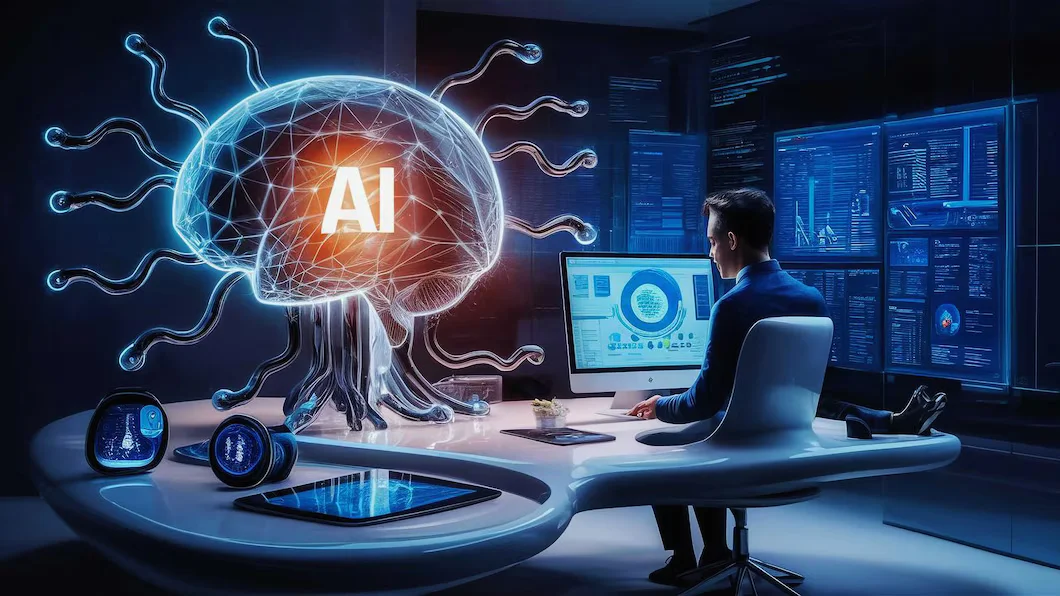Introduction
Artificial Intelligence (AI) has evolved from a niche area of computer science to a transformative force reshaping industries and daily life. This article provides a detailed exploration of AI technologies, their applications, ethical considerations, and future directions. By delving into the specifics of AI’s components and their implications, we aim to offer a nuanced understanding of this rapidly advancing field.
Understanding Artificial Intelligence
Defining AI and Its Evolution
Artificial Intelligence encompasses the creation of computer systems capable of performing tasks that typically require human intelligence. From early rule-based systems to today’s sophisticated neural networks, AI has progressed significantly. The field now emphasizes data-driven models that enable machines to learn and adapt from experience. Key milestones in AI’s evolution include:
- Early AI (1950s-1960s): Rule-based systems with limited flexibility.
- Machine Learning Era (1980s-2000s): Introduction of algorithms that learn from data.
- Modern AI (2010s-Present): Advanced neural networks and deep learning, with applications ranging from autonomous vehicles to natural language processing.
Types of AI
AI is categorized into three primary types:
- Narrow or Weak AI: Designed for specific tasks, such as voice assistants (e.g., Siri) or image recognition systems. These systems excel in their defined functions but lack general intelligence.
- General or Strong AI: Hypothetical AI that possesses general cognitive abilities similar to human intelligence. It is capable of understanding, learning, and applying knowledge across diverse domains.
- Artificial Superintelligence: An AI system that surpasses human intelligence in all areas. This concept remains speculative and is a subject of ongoing debate and research.
Machine Learning
Crucial Pillar of AI
Machine Learning (ML) is a subset of AI focused on enabling machines to learn from data and improve performance over time without explicit programming. ML encompasses several paradigms:
- Supervised Learning: Machines learn from labeled training data to make predictions or classify data (e.g., spam detection in emails).
- Unsupervised Learning: Machines identify patterns and relationships in unlabeled data (e.g., customer segmentation).
- Reinforcement Learning: Machines learn through trial and error, receiving rewards or penalties based on their actions (e.g., game-playing AI).
Deep Learning and Neural Networks
Deep Learning, a specialized form of ML, utilizes neural networks with multiple layers (deep neural networks). These models mimic the human brain’s structure and are particularly effective for tasks like:
- Image and Speech Recognition: Identifying objects or transcribing spoken words.
- Natural Language Processing (NLP): Understanding and generating human language.
- Complex Decision-Making: Making decisions based on large and diverse data sets.
Natural Language Processing (NLP)
Enabling Machines to Understand Language
NLP is a branch of AI that focuses on enabling machines to understand, interpret, and respond to human language in a meaningful way. Key applications of NLP include:
- Virtual Assistants: Systems like Alexa and Google Assistant that interact with users through natural language.
- Language Translation: Tools like Google Translate that convert text between languages.
- Sentiment Analysis: Analyzing text to determine the sentiment behind it, useful in customer feedback and social media monitoring.
Challenges in NLP
Despite advancements, NLP faces several challenges:
- Context Understanding: Machines struggle with understanding context and nuance in human language.
- Handling Ambiguity: Ambiguous phrases or idiomatic expressions can be difficult for NLP systems to interpret accurately.
- Conversational Understanding: Achieving a natural, flowing conversation with machines remains a complex task.
Computer Vision
Interpreting Visual Information
Computer Vision enables machines to interpret and understand visual information from the world. This field employs techniques such as:
- Image Analysis: Extracting meaningful information from images (e.g., detecting tumors in medical scans).
- Object Recognition: Identifying objects within images or video (e.g., facial recognition systems).
- Autonomous Systems: Enabling self-driving cars to interpret their surroundings.
Applications of Computer Vision
Computer Vision has numerous applications across various industries:
- Healthcare: Analyzing medical images for diagnosis and treatment planning.
- Manufacturing: Quality control and defect detection in production lines.
- Retail: Enhancing customer experiences with virtual try-ons and personalized recommendations.
Robotics and AI in Action
Integration of AI in Robotics
The convergence of AI and robotics has led to the development of intelligent robots capable of autonomous decision-making. These robots use AI technologies for:
- Perception: Understanding and interpreting their environment.
- Action Planning: Deciding on actions based on environmental input.
- Adaptation: Adjusting to changing circumstances and tasks.
Applications of AI in Robotics
AI-powered robots are making significant impacts in various sectors:
- Healthcare: Surgical robots assist in precise procedures, enhancing accuracy and outcomes.
- Exploration: Autonomous drones and robots explore hazardous or inaccessible areas.
- Service Industries: Robots are used in hospitality and retail to assist customers and perform routine tasks.
AI in Healthcare
Revolutionizing Diagnosis and Treatment
AI is transforming healthcare by:
- Enhancing Diagnostic Accuracy: AI algorithms analyze medical data to identify patterns and anomalies.
- Personalizing Treatment Plans: Tailoring treatments based on individual patient data.
- Improving Patient Outcomes: AI assists in early detection and preventive care.
Challenges and Ethical Considerations
The adoption of AI in healthcare presents challenges:
- Data Privacy: Ensuring the protection of sensitive patient information.
- Algorithm Bias: Addressing biases that may affect diagnostic and treatment decisions.
- Ethical Implications: Balancing the benefits of AI with ethical considerations in medical decision-making.
AI in Business and Finance
Optimizing Operations and Decision-Making
AI technologies are reshaping business and finance through:
- Operational Optimization: Automating routine tasks and streamlining processes.
- Data-Driven Insights: Using AI for predictive analytics and strategic decision-making.
- Fraud Detection: Identifying fraudulent activities and enhancing security measures.
Applications in Business
- Chatbots: Providing customer support and improving engagement.
- Predictive Analytics: Forecasting trends and making data-driven decisions.
- Risk Management: Analyzing financial risks and mitigating potential threats.
The Future of AI
Continued Advancements and Challenges
The future of AI holds promise for continued innovation, with emerging areas of research such as:
- Explainable AI: Developing AI systems that provide transparent and understandable decision-making processes.
- Quantum Computing: Leveraging quantum computers to solve complex problems beyond current capabilities.
- AI Ethics: Addressing ethical issues and ensuring responsible AI development and deployment.
Addressing Future Challenges
To navigate the evolving landscape of AI, addressing challenges such as:
- Transparency: Ensuring AI systems are transparent and their decisions can be understood.
- Bias Mitigation: Working to eliminate biases in AI algorithms and applications.
- Socio-Economic Impacts: Assessing the broader effects of AI on employment, economy, and society.
Conclusion
Artificial Intelligence continues to revolutionize various aspects of our lives through its diverse technologies and applications. By examining the core components of AI, including machine learning, natural language processing, and computer vision, as well as addressing ethical considerations and future challenges, this article aims to provide a comprehensive understanding of AI’s transformative potential. As AI advances, fostering a balanced approach that embraces innovation while addressing ethical and societal impacts will be crucial for harnessing its full potential and ensuring its benefits are realized responsibly.



